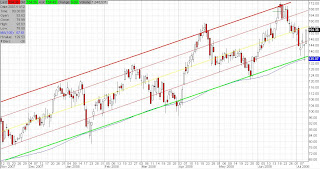Wednesday, July 30, 2008
PetroBras (PBR)
The Dow
Fertilizer rally
Tuesday, July 29, 2008
Fertilizer Still Going

Thursday, July 24, 2008
Potash (POT)
CROX
Almost all stocks eventually go to $0 (effectively if not literally), and they spend the vast majority of their life cycles going down. For this reason, most traders lose money in the market because by going long, they are trying to swim upstream.
Tuesday, July 22, 2008
CF, POT, and MOS


Monday, July 21, 2008
Commodities Intact

Apple (AAPL)

Friday, July 18, 2008
Canaries
Thursday, July 17, 2008
CF and SIRI
Monday, July 14, 2008
Fertilizer rally

Citigroup
Sunday, July 13, 2008
Broad market
Wednesday, July 9, 2008
Ag rally
Tuesday, July 8, 2008
Ag breakdown?

Click charts to enlarge
The chart at the top is all-important OIL. It just fell back to the middle of its channel to 84.91, after hitting a low of 83.60. Meanwhile, the Dow didn't rally. It's not a good scenario. Now OIL has room to run to the top of its channel, currently at 89, sending the Dow on another leg down. We're predicting a sharp jump in OIL to the top of its channel triggering a capitulative washout move in the Dow, allowing at least a short term bottom to be put in. But when?
Meanwhile, the chart of MOS (bottom chart) is getting too "comfortable" hanging out near its support. Charts usually bounce off of support levels quickly. When they hover over them for extended periods of time, it's often (but not always) a warning sign. If MOS does break down, it will not be a slow, multi-day event. It will be a sharp drop, gaining momentum as more and more traders realize that support has been decisively broken. It does not mean that Ag is dead. As long as the majority of the stocks in a sector remain in their channels, we can have a new move to the upside. CF is nearing the bottom, but POT and AGU are far from a breakdown. If a break of the channel happens, we're going to treat it as a buying opportunity, loading up primarily on shares of AGU. We would normally be more heavily invested at this stage of the game, but the action of the broader market makes us cautious. We're only 51% invested, and hedged with a healthy dose of SMN to boot.
Channel trading unfortunately is sometimes not as simple as it appears. Every time stocks approach the bottoms of their channels, you have to prepare for the worst, and try to get in with the least possible damage. Even when our timing is excellent, our portfolio spends some time under water before making new highs. Let's just hope we get that OIL spike soon to stop this slow bleed, which is never a comfortable market to be long in.
Thursday, July 3, 2008
Mosaic - MOS
Wednesday, July 2, 2008
Where's the bottom?



















